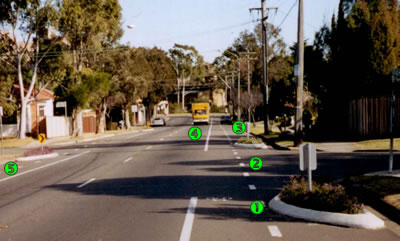Feature: Cycle Lane Design
The Problem
Recently CAMWEST produced a report on cycling issues in the Parramatta area. Although Parramatta Council has been doing some great work, including a significant increase in their cycling budget, there are a number of areas for improvement. Our report details several instances where roads have been made unsafe for cyclists, through the width and positioning of curb blisters and centre islands.
 One of the key problem is that wide
curb blisters create squeeze points and the wide
centre island removes the road space once used by cyclists,
forcing cyclists into the path of the traffic. Alarmingly,
this is often done in recognised cycle routes.
One of the key problem is that wide
curb blisters create squeeze points and the wide
centre island removes the road space once used by cyclists,
forcing cyclists into the path of the traffic. Alarmingly,
this is often done in recognised cycle routes.

Oakes Road looking south to Old Windsor Road
The wide curb blisters create squeeze points, forcing cyclists into the path of the traffic. This is particularly dangerous in a left curve as shown above.
How to Do It Right
 Hover over the numbers for an explanation
Hover over the numbers for an explanation
Here is a photo of Hannan's Rd Riverwood, CAMWEST's preferred design for on-road cycle lanes. (Hover over the green numbers to see an explanation).
- Avoids chicanes, so cyclists are not forced to weave in and out of traffic.
- Dashed lines reminds drivers coming from a side street to look out for cyclists.
- Once the line is drawn, cars stick to their space. Note how the car is parked within the lines, while the truck is keeping to the traffic lane. There is clear space 'claimed' for the cyclists.
- The motor traffic lane is wide enough: note how the truck can easily fit. However, it's narrower so it slows traffic down. This increases safety for all: drivers, cyclists, and pedestrians.
- Increases area for pedestrians. A 'safety buffer' area is provided for children who may move onto the road where it's needed, between the footpath and the car traffic.
The RTA is also implementing this design in its new road works where there is room on-road. CAMWEST would like to see this design implemented throughout the Parramatta LGA by Parramatta Council.
The design just fits on 12.8m wide roads. It is easily implemented on roads 13m or wider. Clyde St Granville, for example, is 13.2m wide, more than adequate room.
There are advantages all round. The limited traffic lane width (3.0m) reduces traffic speeds. The cycle lane gives space for cyclist safety but also allows pedestrians to move out past the parked cars where they can be easily seen by motorists and limits the pedestrian zone of conflict to 6.0m.
The straight travel of the traffic puts much less stress on the pavement and so reduces pavement failure that is so inherent with LATMs that cause changes of direction thus reducing the council maintenance costs.
Next Steps
This proposal will hopefully be considered in the next meetings of the Parramatta Traffic Committee and Parramatta Cycleways Committee.
There have been some very good signs coming out from Parramatta Council of their increasing commitment to cycling facilities. We hope this will continue, with the adoption of this design for most cycle lanes, particularly in acknowledged cycle routes.
Read More
Parramatta Cycling Report Article
Download Parramatta Cycling Issues Report (PDF, 686Kb)
What you can do
See our Action Corner.
